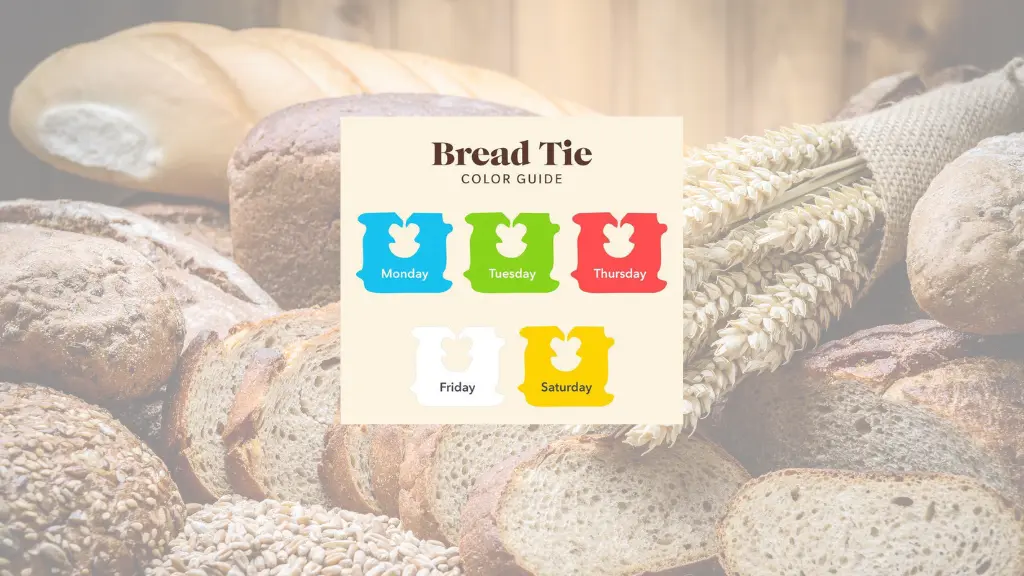When you grab a loaf of bread at the grocery store, do you ever pay attention to the color of the twist tie sealing the bag? It turns out that the color isn’t just random—it’s actually part of a clever system used by bakeries and grocery stores to indicate the freshness of the bread. Yes, the color of that small twist tie can reveal when the loaf was baked, helping you make better decisions about what to buy.
In this article, we’ll dive into the secret meaning behind the color-coded twist ties and why it’s helpful to understand this simple yet effective system. Plus, we’ll offer some extra tips on how to keep your bread fresher for longer!
You May Also Like: Amazing Places to Eat in Bologna Right Now: A Culinary Tour
The Color Code System: What Each Twist Tie Means
Bread typically arrives in stores several times a week, and to keep track of the baking schedule, bakeries use a color-coded system on the twist ties or plastic clips that seal the bread bag. Here’s the breakdown of what the twist tie colors mean:
- Monday – Blue
- Tuesday – Green
- Thursday – Red
- Friday – White
- Saturday – Yellow
If you’re wondering why there’s no bread delivered on Wednesday or Sunday, it’s because most bakeries either skip these days for restocking or choose to use existing loaves from earlier in the week.
This system helps grocery store employees rotate the stock and remove older loaves to ensure freshness. And for you as a shopper, understanding this code can help you pick the freshest bread available.
How to Use the Twist Tie Color to Choose Fresh Bread
When you’re at the store, take a moment to look at the color of the twist tie or plastic clip on your bread. This color tells you when the bread was baked, helping you avoid buying a loaf that might be nearing its expiration date. For example, if today is Thursday and you see a blue twist tie (Monday’s bread), it might not be as fresh as a loaf with a red twist tie (Thursday’s bread).
Here’s how you can use this system to your advantage:
- Shopping on a Thursday? Look for bread with a red twist tie for the freshest loaf.
- Shopping on a Saturday? Go for bread with a yellow twist tie baked that day.
By following this simple method, you can ensure that the bread you’re buying is as fresh as possible.
Why the Twist Tie Color Matters
While it might seem like a small detail, the twist tie color matters because bread doesn’t stay fresh forever. Over time, bread can lose its texture, develop mold, or become stale. Knowing when your bread was baked gives you a better idea of how long it will stay fresh once you bring it home.
Additionally, the color-coded system is not only used in major grocery chains but also in many small bakeries. This makes it a universal guide that can be used in a variety of settings, allowing both store employees and customers to keep track of the bread’s shelf life.
What If Your Bread Has No Twist Tie?
Sometimes, you may come across a loaf of bread that doesn’t have a twist tie but instead uses a plastic clip or even no closure at all. Don’t worry—the same color-coding system typically applies to plastic clips, which are often found on loaves from national brands or larger grocery stores. Even without a twist tie, you can check the color of the clip for the same freshness information.
If the bread doesn’t have any closure at all, look for a sell-by date or baking date printed on the packaging. This will give you another way to gauge the bread’s freshness.
Other Tips to Keep Your Bread Fresher for Longer
While knowing the color-coded system for bread twist ties is helpful, it’s also important to store your bread properly once you get it home. Here are some simple tips to keep your bread fresh and delicious for as long as possible:
- Store bread in a cool, dry place: Bread should be kept at room temperature in a breadbox, pantry, or kitchen counter. Storing it in the refrigerator can actually make it stale faster due to the dry environment.
- Use the freezer for long-term storage: If you won’t finish a loaf within a few days, consider freezing it. You can freeze the entire loaf or slice it first so you can easily grab a portion when needed. Bread can last up to three months in the freezer if wrapped properly.
- Keep it sealed: After each use, reseal the bag tightly to keep air out. You can reuse the twist tie or clip, or even use a clothespin to ensure the bread stays fresh.
- Buy smaller loaves: If you often find yourself throwing away stale bread, consider purchasing smaller loaves that you can finish more quickly. Many bakeries offer half-loaves, which are perfect for smaller households.
- Use stale bread creatively: If your bread does start to go stale, don’t toss it! You can use it to make homemade croutons, breadcrumbs, or even bread pudding.
Why This Hack Is Still Relevant
The twist tie color system is a simple and effective way to ensure you’re getting the freshest bread possible. Though it’s not commonly advertised, it’s been in use for decades and continues to be an essential tool in grocery stores around the world.
In an era of increasingly complex food packaging and labeling systems, the humble twist tie remains a reliable indicator of freshness, especially when combined with savvy shopping habits.
Conclusion: The Next Time You Buy Bread, Check the Twist Tie
Next time you find yourself in the bakery aisle, don’t just grab any loaf. Instead, check the twist tie color to ensure you’re taking home the freshest bread possible. This simple hack can help you avoid stale bread and get more value out of every loaf.
So, the secret’s out—those little twist ties are more than just a way to keep your bread bag closed. They’re a hidden guide to freshness that every savvy shopper should know. Happy bread shopping!










